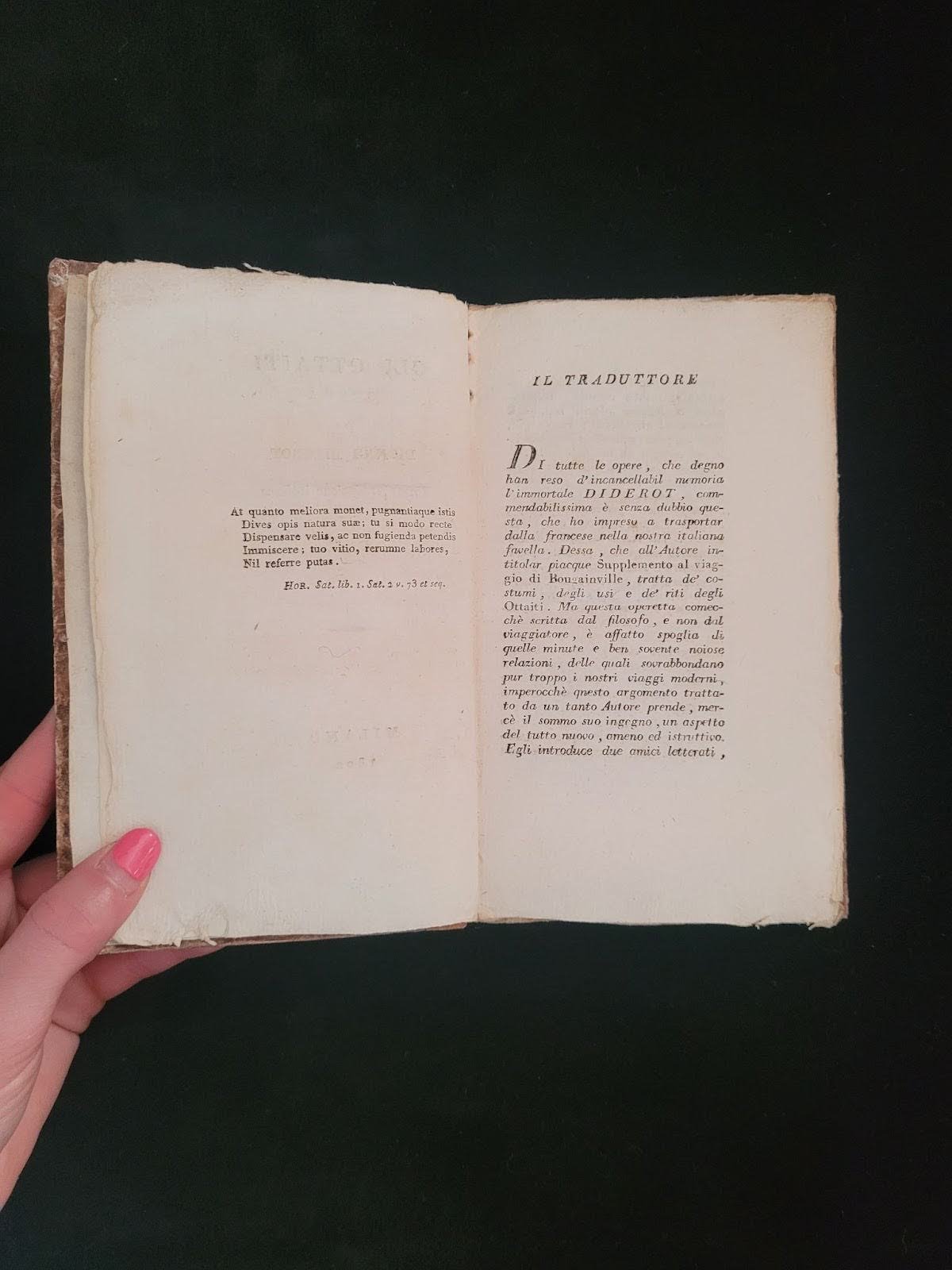 Image 1 of
Image 1 of


Gli Ottaiti, Opera di Dionigi Diderot, Prima Traduzione Italiana di D.
DIDEROT, Denis.
Gli Ottaiti, Opera di Dionigi Diderot, Prima Traduzione Italiana di D.
V. Milan: Gaetano Brocca, 1802.
Small 8vo. (179 x 105 mm); marbled boards backed in tan goatskin, ruled and lettered in gilt direct to spine; outer edges untrimmed; pp. [iii], 4-111, [v]; boards a little compressed at edges with bumps to corners and some chipping to the marbled paper; a little rubbed at spine ends, with a couple of wormholes and evidence of worming to the internal gutters, binding holding firm; discrete evidence of bookplate removal from front paste-down; an internally clean copy, predominantly; with light spotting, particularly to the endleaves and a couple of central pages; pages a little creased in a places with one small ink mark to title; a very good copy, still.
The first Italian edition of Diderot’s Supplément au Voyage de Bougainville, originally published in 1796. It is a set of philosophical dialogues inspired by Louis Antoine de Bougainville’s Voyage Autour du monde. It was written in 1772 for the journal Correspondance littéraire , which Mommissioned him to review Bougainville’s account of his travels, but not published until 1796.
The Supplement spans either four or five chapters, depending on the edition. Each takes the form of a dialogue between two people, but the characters and setting vary. Chapter two features a Tahitian Elder addressing a hypothetical Bougainville; chapters three and four are between a villager named Orou and his European almoner guest; in chapters one and five, speakers known only as “A” and “B” speak in a literary space apart from Tahiti, commenting on and drawing lessons from the noted differences between Tahitian and European culture.
In each of the dialogues, Diderot aligns one character with European culture and the other with Tahitian culture for the purpose of contrasting the two. This kind of nature–culture divide was a common strategy to critique aspects of European culture.
DIDEROT, Denis.
Gli Ottaiti, Opera di Dionigi Diderot, Prima Traduzione Italiana di D.
V. Milan: Gaetano Brocca, 1802.
Small 8vo. (179 x 105 mm); marbled boards backed in tan goatskin, ruled and lettered in gilt direct to spine; outer edges untrimmed; pp. [iii], 4-111, [v]; boards a little compressed at edges with bumps to corners and some chipping to the marbled paper; a little rubbed at spine ends, with a couple of wormholes and evidence of worming to the internal gutters, binding holding firm; discrete evidence of bookplate removal from front paste-down; an internally clean copy, predominantly; with light spotting, particularly to the endleaves and a couple of central pages; pages a little creased in a places with one small ink mark to title; a very good copy, still.
The first Italian edition of Diderot’s Supplément au Voyage de Bougainville, originally published in 1796. It is a set of philosophical dialogues inspired by Louis Antoine de Bougainville’s Voyage Autour du monde. It was written in 1772 for the journal Correspondance littéraire , which Mommissioned him to review Bougainville’s account of his travels, but not published until 1796.
The Supplement spans either four or five chapters, depending on the edition. Each takes the form of a dialogue between two people, but the characters and setting vary. Chapter two features a Tahitian Elder addressing a hypothetical Bougainville; chapters three and four are between a villager named Orou and his European almoner guest; in chapters one and five, speakers known only as “A” and “B” speak in a literary space apart from Tahiti, commenting on and drawing lessons from the noted differences between Tahitian and European culture.
In each of the dialogues, Diderot aligns one character with European culture and the other with Tahitian culture for the purpose of contrasting the two. This kind of nature–culture divide was a common strategy to critique aspects of European culture.
DIDEROT, Denis.
Gli Ottaiti, Opera di Dionigi Diderot, Prima Traduzione Italiana di D.
V. Milan: Gaetano Brocca, 1802.
Small 8vo. (179 x 105 mm); marbled boards backed in tan goatskin, ruled and lettered in gilt direct to spine; outer edges untrimmed; pp. [iii], 4-111, [v]; boards a little compressed at edges with bumps to corners and some chipping to the marbled paper; a little rubbed at spine ends, with a couple of wormholes and evidence of worming to the internal gutters, binding holding firm; discrete evidence of bookplate removal from front paste-down; an internally clean copy, predominantly; with light spotting, particularly to the endleaves and a couple of central pages; pages a little creased in a places with one small ink mark to title; a very good copy, still.
The first Italian edition of Diderot’s Supplément au Voyage de Bougainville, originally published in 1796. It is a set of philosophical dialogues inspired by Louis Antoine de Bougainville’s Voyage Autour du monde. It was written in 1772 for the journal Correspondance littéraire , which Mommissioned him to review Bougainville’s account of his travels, but not published until 1796.
The Supplement spans either four or five chapters, depending on the edition. Each takes the form of a dialogue between two people, but the characters and setting vary. Chapter two features a Tahitian Elder addressing a hypothetical Bougainville; chapters three and four are between a villager named Orou and his European almoner guest; in chapters one and five, speakers known only as “A” and “B” speak in a literary space apart from Tahiti, commenting on and drawing lessons from the noted differences between Tahitian and European culture.
In each of the dialogues, Diderot aligns one character with European culture and the other with Tahitian culture for the purpose of contrasting the two. This kind of nature–culture divide was a common strategy to critique aspects of European culture.

